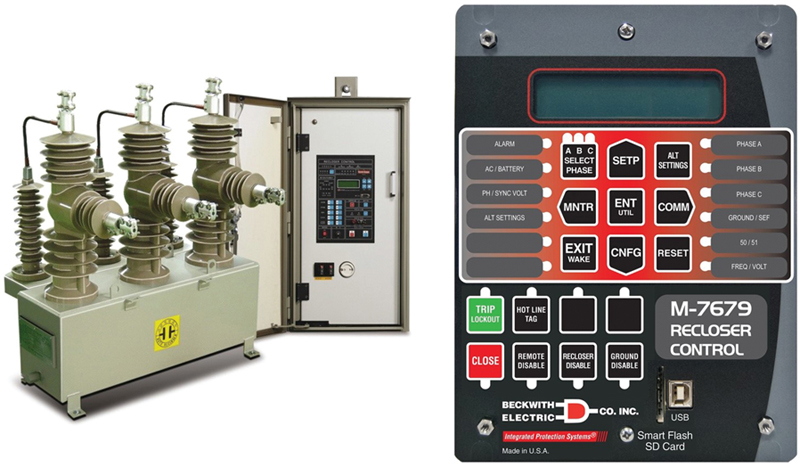References
[1] Basak P, Chowdhury S, HalderneeDey S, Chowdhury SP. A literature review on integration of distributed energy resources in the perspective of control, protection and stability of microgrid. Renew Sust Energ Rev. 2012;16:5545–5556.
[2] Jenkins N, Ekanayake JB, Strbac G. Distributed generation. London, UK: Institution of Engineering and Technology; 2010.
[3] Tanaka K, Yoza A, Ogimi K, Yona A, Senjyu T, Funabashi T, Kim C-H. Optimal operation of DC smart house system by controllable loads based on smart grid topology. Renewable Energy 2012;39(1): 132–139.
[4] Goya T, Senjyu T, Yona A, Urasaki N, Funabashi T, Kim C-H. Optimal operation of controllable load and battery considering transmission constraint in smart grid. The 9th International Power and Energy Conference, no. P0378, Suntec, Singapore, 27–29 October 2010, pp. 734–739.
[5] Che L, Khodayar ME, Shahidehpour M. Adaptive protection system for microgrids: protection practices of a functional microgrid system. IEEE Electrific Mag. 2014;2(1):66–80.
[6] Dugan RC, McGranaghan MF, Santoso S, Beaty HW. Electrical power system quality. 2nd ed. New York: McGraw-Hill, 2004.
[7] Comech MP, Gracia MG, Borroy S, Villen MT. Protection in distributed generation. In: Gaonkar DN, editor, Distributed generation, ISBN:978-953-307-046 9; 2010.
[8] Javadian SAM, Haghifam M-R, Bathaee SMT, Fotuhi Firoozabad M. Adaptive centralized protection scheme for distribution systems with DG using risk analysis for protective devices placement. Int J Elec Power. 2013;44(1):337–345.
[9] Jiayi H, Chuanwen J, Rong X. A review on distributed energy resources and microgrid. Renew Sust Energ Rev. 2008;12:2472–2483.
[10] Institute of Electrical and Electronics Engineers, Inc. IEEE Standard 1547.7. Guide to conducting distribution impact studies for distributed resource interconnection; 2013. Available from: http://www.techstreet.com/ieee.
[11] COMBIFLEX Generator Protection – Application Guide, 1MRK 502 003-AEN. issued on June, 2004.
[12] Shahidehpour M, Khodayar ME, Barati M, Campus microgrid: high reliability for active distribution systems. Proceedings of IEEE Power Energy Society, General Meeting, July 2012, pp. 1–2.
[13] Ulushki RW. Creating smart distribution through automation. EPRI, USA, PAC, March, 2012.
[14] Yeo S-M, Kim C-H. Analysis of system impact of the distributed generation using EMTP with particular reference to voltage sag. KIEE Int Transact PE. 2004;4-A(3):122–128.
[15] Aggarwal S, Gimon E, et al. Trending topics in electricity today: getting ready for distributed energy resources. Energy Innovation, Policy &Technology LLC; January 20, 2015.
[16] Gamit V, Karode V, Mistry K, Parmar P, Chaudhari A. Fault analysis on three phase system by auto reclosing mechanism. Int J Res Eng Technol. May-2015;04(05):292–298.
[17] Bollen MHJ, Häger M. Power quality: interactions between distributed energy resources, the grid, and other customers. Electric Power Qual Utiliz Mag. 2005;1(1).
[18] Antonova G, Nardi M, et al. Distributed generation and its impact on power grids and microgrids protection. 978-1-4673-1842-6/12/$31.00 ©2012 IEEE.
[19] Häger M, Sollerkvist F, Bollen MHJ. The impact of distributed energy resources on distribution system protection. EU-DEEP integrated project, STRI AB, Ludvika; 2006.
[20] Deuse J, Grenard S, et al. Effective impact of DER on distribution system protection. CIRED 19th International Conference on Electricity Distribution, Vienna, May 21–24, 2007.
[21] Abdel-Galil TK, Ahmed EB, Elanien A, El-Saadany EF, Yasser AG, Mohamed Magdy A-RI, Salama MA, Zeineldin HHM. Protection coordination planning with distributed generation. Presented to Scientific Authority: Chad Abbey Natural Resources Canada (NRCan); June 2007.
[22] Oudalov1 A, et al. Novel protection systems for microgrids. TC2 Technical requirements for network protection; 2009.
[23] Mahat P, Chen Z, et al. A simple adaptive overcurrent protection of distribution systems with distributed generation. IEEE Trans Smart Grid. 2011;2(3):428–437.
[24] Friedman NR. Distributed energy resources interconnection systems: technology review and research needs; September 2002, NREL/SR-560-32459.
[25] Mariah Energy Development Corp. Ellsworth, KS 67439, sighted April 2015.
[26] Strath N. Islanding detection in Power Systems. Licentiate Thesis, Department of Industrial Electrical Engineering and Automation, Lund University; 2005.
[27] Pecas Lopes JA, Moreira CL, Madureira AG. Defining control strategies for microgrids islanded operation. IEEE Trans Power Syst. 2006;21(2):916–924.
[28] Kamel RM, Chaouachi A, Nagasaka K. Three proposed control techniques applied upon inverters which interfacing micro sources with the islanded micro grid. ISESCO J Sci Technol Vis. 2011;7(11):76–84.
[29] Giri V, Illindala M. Microgrids and sensitive loads. Proceedings of IEEE Power Engineering Society Winter Meeting, IEEE Press; 2002, pp. 315–322.
[30] Girgis A, Brahma S. Effect of distributed generation on protective device coordination in distribution system. Proceedings of Large Engineering System Conference on Power Engineering, LESCOPE’01, July 2001, pp. 115–119.
[31] Etemadi AH, Iravani R. Overcurrent and overload protection of directly voltage-controlled distributed resources in a microgrid. IEEE Trans Ind Electron. 2013;60(12).















